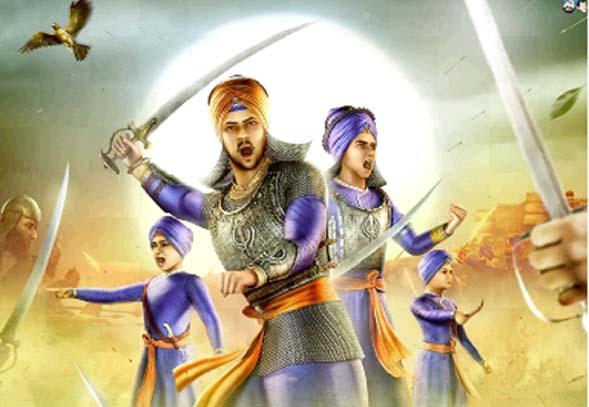While the rest of the world has been celebrating Christmas and getting ready for the New Year, people following Punjabiyat and Sikh Panth all across the world have been remembering Chaar Sahibzaade’s sacrifices. Sahibzaade Ajit Singh Ji, Jujhar Singh Ji, Zorawar Singh Ji, and Fateh Singh Ji, the four sons of the tenth Guru, Guru Gobind Singh ji, were martyred between December 21 and December 27, 1704 AD. Every person revering and following sikh traditions has a distinct memory of these times, and they recall the Sahibzaade with great vigour, valour and profound sorrow. The four “Sahibzaade” martyrdom is an important part of the Indian history.
The four sons of Sri Guru Gobind Singh, are affectionately referred to as Sahibzaade. “Sahibzaade” alludes to the sons, young men of genteel origin, and “Chaar” denotes four. On the chilled night of December 20, 1704, Guru Gobind Singh ji, his wife Mata Jeeto ji, their four sons, Guru’s Mahil, Mata Gujari Kaur, Panj Piaras, and several warriors following panth left the fort of Anandpur Sahib, after the Mughals and Pahaadi King took oaths on the Quran and the holy cow, respectively—both of which are revered in their respective religions—and pledged not to attack the fort.
On the night of December 20–21, however, the Mughals went back on their words and attacked the Guru’s company at a place on the Sarsa rivulet, about 25 kilometres from Anandpur Sahib. The attack’s location is known as Pariwar Vichora, and the Gurudwara Sahib constructed in remembrance of it is called as Gurudwara Pariwar Vichora Sahib. The attack caused the Guru’s family to become divided and break away. Guru’s Mahil and Bhai Mani Singh travelled to Delhi.
On the afternoon of December 21, Guru Gobind Singh Ji travelled to Chamkaur with two senior Sahibzaade, five Panj Piaras, and forty warriors following sikh panth. On December 22, the Khalsa and the elder Sahibzaade, known as the Vadde Sahibzaade—attained martyrdom battling the mammoth Mughal army at the young ages of 18 and 14 respectively—engaged in the famous Chamkaur battle, also known as the Battle of Chamkaur Sahib. 40 warriors following panth and three Panj Piaras lost their lives while battling the ten-thousand strong Mughal army.
Another member who resembled the Guru, Sangat Singh, dressed up like him and remained in the army. After negotiations fell through, the warriors chose to engage with the vast Mughal troops, allowing the Guru to move. The following morning, the last warriors were put to death by Mughal soldiers. During the conflict, the two youngest sons of the Guru, Baba Zorawar and Fateh, as well as their grandmother Mata Gujri, got separated from the others.
Sahibzaade Zorawar Singh and Fateh Singh refused to convert to Islam even at such a young age, remaining faithful and firm to the Khalsa Panth. Wazir Khan thereupon mandated the order to build a brick wall around them. Thus buried alive in bricks, the two Sahibzaade gained martyrdom
Baba Zorawar Singh, Baba Fateh Singh, and their grandmother were detained by Jani Khan and Mani Khan Ranghar, the Morinda officials, on the morning of December 21, 1704, the day of the crucial Battle of Chamkaur, after Gangu revealed their identities to the Mughal authorities. The following day, they were sent to Sirhind, where they were placed in the fort’s Cold Tower (Thanda Burj). The famed Gurdwara Fatehgarh Sahib marks this location. On December 23, 1704, Nawab Wazir Khan, the faujdaar, and his feudal ally, Nawab Sher Muhammad Khan of Malerkotla, who had just returned from Chamkaur, produced Baba Zorawar Singh Ji and Baba Fateh Singh Ji before them.
With promises of wealth and honour, Wazir Khan attempted to get the Sahibzade to convert to Islam, but they rejected the idea. He then threatened to kill them, but they didn’t back down. The two kids were finally given the death penalty. Sahibzade Zorawar Singh and Fateh Singh were given extra time to consider the suggestion to convert after Sher Muhammad pleaded for the lives of the defenceless children to be spared. During the harsh winter, Sahibzade Zorawar Singh and his brother spent additional two days in the Cold Tower on their elderly grandmother’s lap. The two Sahibzaade refused to convert to Islam even at such a young age, remaining faithful and firm to the Khalsa Panth. Wazir Khan thereupon mandated the order to build a brick wall around them. Thus, buried alive in bricks, the two Sahibzaade gained martyrdom. When Mata Gujar Kaur learned that her baby grandsons had been martyred, she was unable to handle the trauma and left that very day for her heavenly abode. On December 26, 1704, a horrifying crime was committed in the Sarzameen of Sirhind. The “Chotte Sahibzaade”, aged 6 and 9, were killed by the Mughals at Sirhind. Jyoti Swaroop Gurudwara Sahib is the name given to this location in Fatehgarh Sahib, Punjab, India. Every year, from December 21 to December 27, the Fatehgarh Sahib Gurudwara holds the Shaheedi Jor Mela in solemn memory of this martyrdom.




















Comments